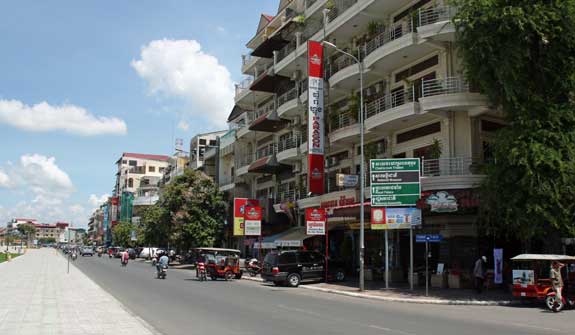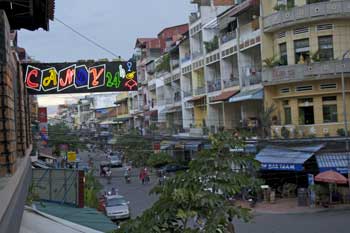Monday Escape: Phnom Penh, Cambodia

Compared to the largest cities in Southeast Asia such as Bangkok, Saigon, and Hanoi, the capital of Cambodia feels like a backwater. In fact, much of the appeal of Phnom Penh is that it’s a relatively laid-back city along a river with a center that can be walked across in 30 minutes or so.
Phnom Penh may be less tourist-friendly than Siem Reap, but its position between the Mekong Delta area of Vietnam and either Bangkok or Angkor Wat means that most slow travelers will stop there anyway. And compared to the manic pace in Bangkok or Saigon, it’s a breath of fresh air as well.
The vibe in Phnom Penh
Pleasantly set along the bank of the Tonlé Sap, Mekong and Bassac rivers, Phnom Penh has a population of well over 2 million, but from a visitor’s standpoint it feels many times smaller. Unlike the other huge cities of Southeast Asia, Phnom Penh has exactly one city center where all the main sights are located, and it’s small enough to walk across when it’s not too hot.
More good news comes in the fact that there are on freeways or other huge roads carrying massive traffic, so even the city center has more of a small-town feel, with only a few streets having more than one lane in each direction. There aren’t a million motorbikes or taxi cabs, so crossing streets is barely a challenge.
 The main tourist district is along the river and within two or three blocks of the road that runs alongside it, which also means that you can walk across town on the sidewalk overlooking the Tonlé Sap, not having to worry about cross traffic at all.
The main tourist district is along the river and within two or three blocks of the road that runs alongside it, which also means that you can walk across town on the sidewalk overlooking the Tonlé Sap, not having to worry about cross traffic at all.
Most of the architecture is modern rather than colonial, with most buildings topping out at only 5 stories or so. The Royal Palace and Silver Pagoda are the main tourist attractions, and will remind visitors of similar monuments in Bangkok. There are various other temples and statues scattered around the city center along with a few notable museums, but it seems to be the pleasant and mellow way of life might be the most appealing thing.
The main river walk is lined with restaurants, shops, and hotels, many popular with tourists and expat workers, with nearly constant happy hour prices of 50 cents for a glass of Angkor Beer available. The nightlife in Phnom Penh does get quite serious, with a surprising number of bars and nightclubs that range from dumpy to very posh, all within a few blocks of each other. It’s also worth noting that there are 4 or 5 clusters of “beer bars” in this same area, where the patrons exclusively consist of single men and prostitutes. When looking for a place to drink you could easily mistake one of these places for a lively hotspot for trendy tourists and locals, so be aware that if you are greeted by many smiling and young local girls that they are of the working variety.
In years past the Foreign Correspondents’ Club was the most popular bar for the English-speaking crowd, and it’s still there, with 9 hotel rooms added, but now there are so many bars and restaurants operated primarily for tourists that you have many dozens of other options.
The cost of living in Phnom Penh
As you might expect, Phnom Penh is quite cheap by international standards, with prices for almost everything very much in line with Vietnam, and a bit cheaper than Thailand. Hotel rooms start at about US$10 per night, and if you are willing to spend around US$25 you can actually get something quite nice. A proper 3-star tourist hotel built to international standards might run US$50 or a bit more, which is still great value compared to most of the world.
There’s plenty of street food available in Phnom Penh, with meals starting at around US$1 each, but most tourists tend to gravitate toward the many restaurants with English menus stationed out front, where a main course will usually cost between US$2 and US$4. Needless to say, there are more expensive restaurants to be found as well, often in the more expensive hotels, but the budget traveler will get great food and service for far less. As mentioned earlier, happy hour prices of the ubiquitous Angkor Beer are around US$0.50 to US$1 almost everywhere, and cocktails start at around US$2 and go way up from there.
It appears that apartments by the month start around US$300 per month if built and kept to the standards that most expats prefer, though local families pay a small fraction of that for basic accommodation. English teachers and those working for NGOs seem to be able to find very good deals by relying on those already there, while getting a similar deal by just walking up might be challenging.
